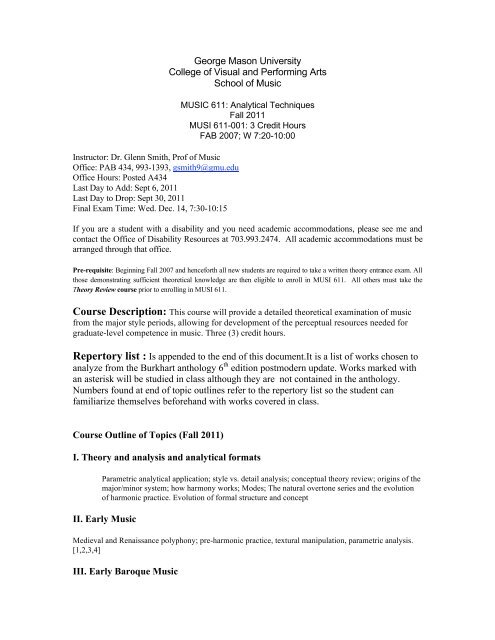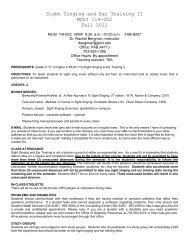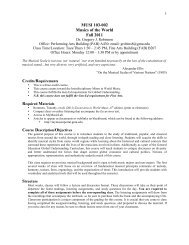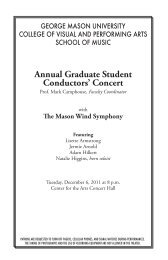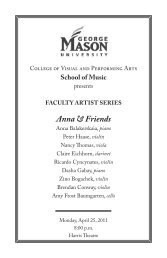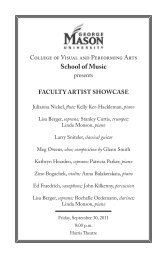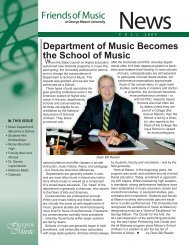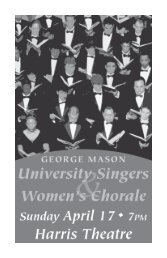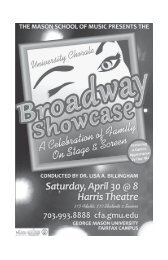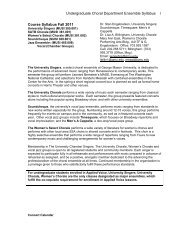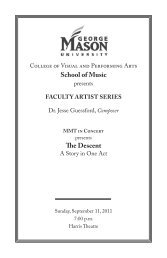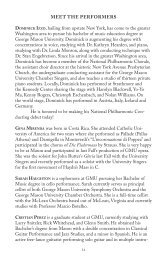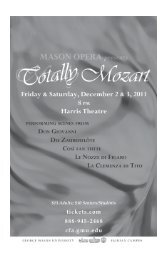syl 611f11 - George Mason University School of Music
syl 611f11 - George Mason University School of Music
syl 611f11 - George Mason University School of Music
You also want an ePaper? Increase the reach of your titles
YUMPU automatically turns print PDFs into web optimized ePapers that Google loves.
Instructor: Dr. Glenn Smith, Pr<strong>of</strong> <strong>of</strong> <strong>Music</strong><br />
Office: PAB 434, 993-1393, gsmith9@gmu.edu<br />
Office Hours: Posted A434<br />
Last Day to Add: Sept 6, 2011<br />
Last Day to Drop: Sept 30, 2011<br />
Final Exam Time: Wed. Dec. 14, 7:30-10:15<br />
<strong>George</strong> <strong>Mason</strong> <strong>University</strong><br />
College <strong>of</strong> Visual and Performing Arts<br />
<strong>School</strong> <strong>of</strong> <strong>Music</strong><br />
MUSIC 611: Analytical Techniques<br />
Fall 2011<br />
MUSI 611-001: 3 Credit Hours<br />
FAB 2007; W 7:20-10:00<br />
If you are a student with a disability and you need academic accommodations, please see me and<br />
contact the Office <strong>of</strong> Disability Resources at 703.993.2474. All academic accommodations must be<br />
arranged through that <strong>of</strong>fice.<br />
Pre-requisite: Beginning Fall 2007 and henceforth all new students are required to take a written theory entrance exam. All<br />
those demonstrating sufficient theoretical knowledge are then eligible to enroll in MUSI 611. All others must take the<br />
Theory Review course prior to enrolling in MUSI 611.<br />
Course Description: This course will provide a detailed theoretical examination <strong>of</strong> music<br />
from the major style periods, allowing for development <strong>of</strong> the perceptual resources needed for<br />
graduate-level competence in music. Three (3) credit hours.<br />
Repertory list : Is appended to the end <strong>of</strong> this document.It is a list <strong>of</strong> works chosen to<br />
analyze from the Burkhart anthology 6 th edition postmodern update. Works marked with<br />
an asterisk will be studied in class although they are not contained in the anthology.<br />
Numbers found at end <strong>of</strong> topic outlines refer to the repertory list so the student can<br />
familiarize themselves beforehand with works covered in class.<br />
Course Outline <strong>of</strong> Topics (Fall 2011)<br />
I. Theory and analysis and analytical formats<br />
Parametric analytical application; style vs. detail analysis; conceptual theory review; origins <strong>of</strong> the<br />
major/minor system; how harmony works; Modes; The natural overtone series and the evolution<br />
<strong>of</strong> harmonic practice. Evolution <strong>of</strong> formal structure and concept<br />
II. Early <strong>Music</strong><br />
Medieval and Renaissance polyphony; pre-harmonic practice, textural manipulation, parametric analysis.<br />
[1,2,3,4]<br />
III. Early Baroque <strong>Music</strong>
IV. Baroque<br />
Style characteristics and analysis <strong>of</strong> early Baroque music. [5,6]<br />
Handel; Bach selected works;, Variation forms and fugal procedures.[7,8,9,10,11]<br />
V, VI. Classical<br />
Evolution <strong>of</strong> sonata form from Baroque to Classical. Sonata forms, & variants. Evolution<br />
<strong>of</strong> formal principles; sonata and rondo. Later sonata.[12, 13,14,15,16,17,18]<br />
VII. Romantic<br />
German Lied; Chopin & Wagner; Parametric analysis; formal expansion; tonal expansion<br />
and chromatic harmonic practice. [19,20,21,23]<br />
VIII. Impressionism & early 20 th century<br />
Debussy. Stravinsky, Ives,; parametric analysis; free forms; chromatic expansion as<br />
color/texture, pre-20 th century harmonic extensions., symmetrical scales and pitch<br />
centricity. Hindemith Series 1& 2. [24,25,26,27,28]<br />
IX 20th Century (serial and non-serial music)<br />
Bartok, Stravinsky, Messiaen, Crumb, Webern: selections. 20 th century analysis including<br />
set theory and serial procedures. [27,28,29,30]<br />
X. Later 20th Century<br />
Course Text<br />
Riley, Reich, Bryars: selections. parametric analysis. musical process as structure;<br />
serialization, and isorhythm. Schenkarian analysis; motif development; shape and textural<br />
considerations; chromatic expansion as color/texture; concept <strong>of</strong> "pulse-phase<br />
minimalism" .[29,31,32]<br />
1. Burkhart, Charles, Anthology for <strong>Music</strong>al Analysis, 6 th edition<br />
2. Supplimental materials will be handed out in class.<br />
Grading<br />
Grades will be determined on a point basis from written assignments, analytical papers, and tests. An<br />
analytical paper will be required near the end <strong>of</strong> the semester. Specific information as to its content and<br />
format will be given in class. Mid-term and final tests will be given.<br />
Other:In addition to the formal study <strong>of</strong> works listed above, there will be frequent listening/aural analyses<br />
<strong>of</strong> music. Students are expected to monitor their GMU e-mail accounts daily as this class may require mailings<br />
<strong>of</strong> hand-out materials, assignment materials, supplimentary instructions, etc as e-mail attachments. Please make<br />
sure your account has sufficient space available to receive course materials. Repertory list follows
Composer & title Page # Style, category, or form<br />
1. Machaut-De Bon Espoir 9 Isorhythmic motet; rhythmic modes; cantus firmus<br />
technique<br />
2. Dufay- Communio 14 Fauxbourdon w/ cantus firmus<br />
3. Josquin- Tu Pauperum 16 Ear;y voice leading, incipient vertical texture<br />
4. Josquin-Baises moy 19 Canonic voice leading; quasi functionality; controlled<br />
dissonance<br />
5.Palestrina –Missa aeterna<br />
Christi<br />
22 Plainchant as musical source material<br />
6. Gesualdo- Moro Lasso 39 Post Renaissance verticality<br />
7. Corelli-trio sonata Op. 4 53 Early binary form<br />
No. 11<br />
8. Purcell-Dido’s Lament 55 Use <strong>of</strong> ground; Baroque bass line<br />
9. Handel -Air 76 Variation technique<br />
10. Bach –Chaconne d minor 94 Harmonic variation technique<br />
11.Bach- c major Prelude; g 104, Key area determination; fugue vs. prelude<br />
minor fugue<br />
107<br />
12. Haydn- Sonata 36- I 137 Monothematic sonata allegro<br />
13. Haydn- Sonata 37-III 140 Rondo techniques<br />
14. Clementi- Sonatina G 161 Simple sonata prototype<br />
15 Mozart- K 333 Bb 175 Sonata form<br />
16 Beethoven-Sonata 1 in f 219 Sonata form<br />
17. Beethoven- Op 7 Eb II and 225, 2 nd movement structure<br />
Op 10 II<br />
228<br />
18. Beethoven-Waldstein 263 Expanded sonata allegro<br />
19. Schubert - Doppelganger 294 German Lied<br />
20. Schubert- Erlkonig 296 German Lied, chromaticism<br />
21. Chopin-E min Prelude 326 Romantic chromaticism & harmonic coloration<br />
22. Chopin- C min Prelude 331 Romantic chromaticism<br />
23. Wagner- Tristan Prelude 334 Leitmotiv technique; Romantic form<br />
24.Debussy- Sunken<br />
Cathedral<br />
421 Impreessionistic style and vocabulary<br />
25. Ives- The Cage 435 Early 20 th century<br />
26. Ives- General Booth 436 Collage and 20 th century texture as form<br />
27. Bartok- <strong>Music</strong> for Strings, 453 20 th century fugal technique<br />
Perc.<br />
28. Hindemith- A Swan 488 Series 1 and 2<br />
29. Messiaen-Crystal Liturgy 502 20 th century isorhythmic technique<br />
30 Webern-Wie bin Ich fro 482 Dodecaphonic technique<br />
31. Riley – In C 531 Process as form<br />
32.* Reich,- Come Out;<br />
;Bryars- Jesus Blood<br />
*** Pulse phase minimalism; 21 st century concepts


